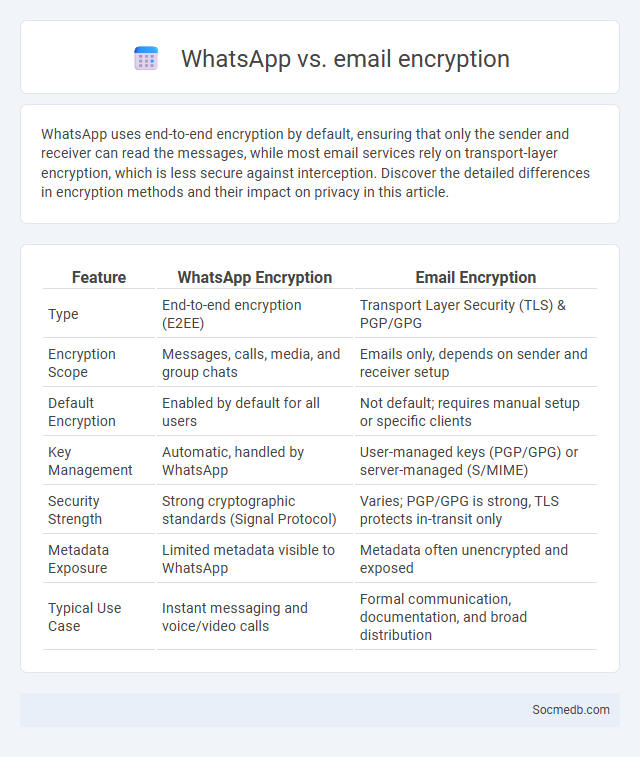
Photo illustration: WhatsApp vs email encryption
WhatsApp uses end-to-end encryption by default, ensuring that only the sender and receiver can read the messages, while most email services rely on transport-layer encryption, which is less secure against interception. Discover the detailed differences in encryption methods and their impact on privacy in this article.
Table of Comparison
| Feature | WhatsApp Encryption | Email Encryption |
|---|---|---|
| Type | End-to-end encryption (E2EE) | Transport Layer Security (TLS) & PGP/GPG |
| Encryption Scope | Messages, calls, media, and group chats | Emails only, depends on sender and receiver setup |
| Default Encryption | Enabled by default for all users | Not default; requires manual setup or specific clients |
| Key Management | Automatic, handled by WhatsApp | User-managed keys (PGP/GPG) or server-managed (S/MIME) |
| Security Strength | Strong cryptographic standards (Signal Protocol) | Varies; PGP/GPG is strong, TLS protects in-transit only |
| Metadata Exposure | Limited metadata visible to WhatsApp | Metadata often unencrypted and exposed |
| Typical Use Case | Instant messaging and voice/video calls | Formal communication, documentation, and broad distribution |
Understanding WhatsApp Encryption
WhatsApp encryption uses end-to-end technology to ensure that only you and the person you're communicating with can read or listen to messages. This encryption protects your chats, calls, photos, and videos from being accessed by hackers, WhatsApp itself, or third parties. Understanding this secure communication method helps you maintain privacy and confidence in your social media interactions.
What is Email Encryption?
Email encryption is a security technology that protects email content by converting it into unreadable code, preventing unauthorized access during transmission. It uses algorithms to ensure that only the intended recipient with the correct decryption key can read the message, maintaining privacy and confidentiality. Common protocols for email encryption include S/MIME and PGP, widely adopted in personal and professional communication to safeguard sensitive information from cyber threats.
Defining End-to-End Encryption
End-to-end encryption (E2EE) is a security protocol that ensures only the communicating users can read the messages exchanged, preventing third parties, including service providers, from accessing the content. In social media platforms, E2EE encrypts messages on the sender's device and decrypts them solely on the recipient's device, enhancing user privacy and protecting against data breaches. This encryption method is critical in safeguarding personal conversations and sensitive information from cyber threats and unauthorized surveillance.
How Does WhatsApp's Encryption Work?
WhatsApp's encryption relies on the Signal Protocol, a state-of-the-art end-to-end encryption system ensuring that only the communicating users can read the messages. Each message is secured with a unique lock and key, generated on the sender's and receiver's devices, preventing interception by third parties, including WhatsApp itself. This encryption covers texts, calls, photos, videos, and voice messages, maintaining privacy and security in real-time communication.
Comparing Email and End-to-End Encryption
Email remains a widely used communication tool but often lacks comprehensive end-to-end encryption, leaving messages vulnerable to interception during transit. End-to-end encryption, employed by platforms like Signal and WhatsApp, ensures that only the communicating users can read the messages, enhancing privacy and security. This encryption method safeguards sensitive data against unauthorized access, making it a preferred choice for secure social media communications.
Security Strengths of WhatsApp vs Email
WhatsApp employs end-to-end encryption by default, ensuring that messages can only be read by the sender and recipient, significantly enhancing user privacy compared to traditional email services which often lack such robust encryption protocols. Its use of two-step verification and frequent security updates further bolsters protection against unauthorized access and cyber threats, whereas emails are more vulnerable to phishing attacks and spam infiltration. The centralized authentication within WhatsApp's platform provides a more secure user identity verification compared to the decentralized and often weaker authentication mechanisms found in standard email services.
Limitations of End-to-End Encryption
End-to-end encryption in social media platforms safeguards your messages by ensuring only you and the recipient can read them, but it also limits content moderation and the detection of harmful activities such as hate speech, misinformation, or child exploitation. This encryption restricts platform providers from accessing message contents, complicating efforts to enforce community guidelines or cooperate with law enforcement investigations. Balancing privacy and safety remains a critical challenge as platforms navigate encryption's benefits and its implications for accountability.
Use Cases: When to Choose WhatsApp, Email, or E2EE
Choosing WhatsApp is ideal for instant, secure messaging with end-to-end encryption (E2EE), making it suitable for personal conversations and small group chats requiring privacy. Email remains the preferred platform for formal communication, detailed information exchange, and business correspondence that benefits from archiving and robust search capabilities. End-to-end encrypted (E2EE) channels are crucial when maximum confidentiality is necessary, such as in legal, healthcare, and financial communications, ensuring data protection from sender to recipient.
Privacy Risks and Vulnerabilities
Social media platforms expose users like You to significant privacy risks including unauthorized data access, identity theft, and targeted cyberattacks. Sharing personal information can lead to vulnerabilities such as data breaches and misuse by malicious actors or third-party advertisers. Protecting Your privacy requires careful management of privacy settings and cautious sharing of sensitive details online.
Future Trends in Digital Communication Encryption
Future trends in digital communication encryption emphasize quantum-resistant algorithms to safeguard data against emerging cyber threats. Increased adoption of end-to-end encryption protocols on social media platforms aims to enhance user privacy and secure personal information. Your digital interactions will benefit from evolving encryption standards that prioritize confidentiality and integrity in real-time messaging.
 socmedb.com
socmedb.com